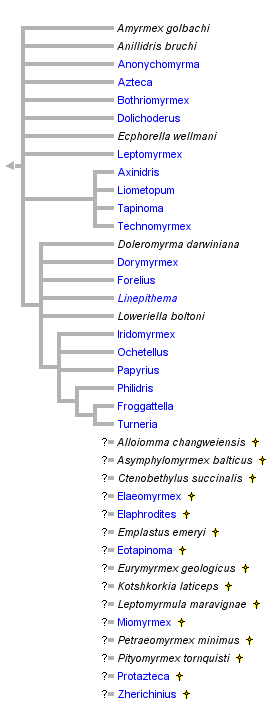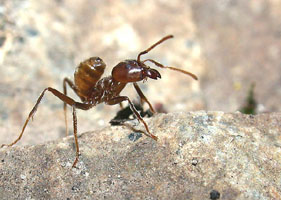Dolichoderinae



This tree diagram shows the relationships between several groups of organisms.
The root of the current tree connects the organisms featured in this tree to their containing group and the rest of the Tree of Life. The basal branching point in the tree represents the ancestor of the other groups in the tree. This ancestor diversified over time into several descendent subgroups, which are represented as internal nodes and terminal taxa to the right.

You can click on the root to travel down the Tree of Life all the way to the root of all Life, and you can click on the names of descendent subgroups to travel up the Tree of Life all the way to individual species.
For more information on ToL tree formatting, please see Interpreting the Tree or Classification. To learn more about phylogenetic trees, please visit our Phylogenetic Biology pages.
close boxIntroduction
The Dolichoderinae share the following characters with the Aneuretinae and Formicinae (Bolton 2003):- Dorsal cuticular flap of the metapleural gland anteriorly reduced and posteromedially extended
- Petiole with complete tergosternal fusion
- Postpygidial glands absent
- Slit-like junction of pygidium and hypopygium
- Sting vestigial
- Pygidial glands producing cyclopenanoid monoterpenes (iridoids)
- Larvae with reduced hairs
- Reduced (sensilliform) larval maxillary palp and galea
- Small larval sericteries and reduced larval neck
References
Bolton, B. 1994. Identification Guide to the Ant Genera of the World. 222 pp. Cambridge, Mass.
Bolton, B. 1995. A New General Catalog of the Ants of the World. 504 pp. Cambridge, Mass.
Bolton, B. 2003. Synopsis and Classification of Formicidae. 370 pp. Memoirs of the American Entomological Institute, Vol. 71. Gainesville, FL.
Brandão, C. R. F., C. Baroni Urbani, J. Wagensberg, and C. I. Yamamoto. 1998. New Technomyrmex in Dominican amber, with a reappraisal of Dolichoderinae phylogeny. Entomologica Scandinavica 29: 411-428.
Chiotis, M., L. S. Jermiin, and R. H. Crozier. 2000. A molecular framework for the phylogeny of the ant subfamily Dolichoderinae. Molecular Phylogenetics and Evolution 17(1): 108-116.
Hölldobler, B. and E. O. Wilson. 1990. The Ants. 732 pp. Harvard University Press.
Shattuck, S. O. 1992a. Higher classification of the ant subfamilies Aneuretinae, Dolichoderinae and Formicidae. Systematic Entomology 17: 199-206.
Shattuck, S. O. 1992b. Generic revision of the ant subfamily Dolichoderinae (Hymenoptera: Formicidae). Sociobiology 21: 1-181.
Shattuck, S. O. 1994. Taxonomic catalog of the ant subfamilies Aneuretinae and Dolichoderinae. University of California Publications in Entomology 112: 1-241.
Shattuck, S. O. 1995. Generic-level relationships within the ant subfamily Dolichoderinae (Hymneoptera: Formicidae). Systematic Entomology 20: 217-228.
Wheeler, G. C. & Wheeler, J. 1976. Ant larvae: review and synthesis. Memoirs of the Entomological Society of Washington 74: 1-108.
Title Illustrations

| Scientific Name | Azteca instabilis |
|---|---|
| Location | Guatemala |
| Sex | Female |
| Life Cycle Stage | Worker |
| Copyright |
© 2003 Alex Wild

|
| Scientific Name | Linepithema humile |
|---|---|
| Location | U.S.A. (California) |
| Sex | Female |
| Life Cycle Stage | Worker |
| Copyright |
© 2003 Alex Wild

|
About This Page
Page copyright © 2004
 Page: Tree of Life
Dolichoderinae.
The TEXT of this page is licensed under the
Creative Commons Attribution-NonCommercial License - Version 3.0. Note that images and other media
featured on this page are each governed by their own license, and they may or may not be available
for reuse. Click on an image or a media link to access the media data window, which provides the
relevant licensing information. For the general terms and conditions of ToL material reuse and
redistribution, please see the Tree of Life Copyright
Policies.
Page: Tree of Life
Dolichoderinae.
The TEXT of this page is licensed under the
Creative Commons Attribution-NonCommercial License - Version 3.0. Note that images and other media
featured on this page are each governed by their own license, and they may or may not be available
for reuse. Click on an image or a media link to access the media data window, which provides the
relevant licensing information. For the general terms and conditions of ToL material reuse and
redistribution, please see the Tree of Life Copyright
Policies.
- First online 20 March 2004
Citing this page:
Tree of Life Web Project. 2004. Dolichoderinae. Version 20 March 2004 (temporary). http://tolweb.org/Dolichoderinae/22202/2004.03.20 in The Tree of Life Web Project, http://tolweb.org/









 Go to quick links
Go to quick search
Go to navigation for this section of the ToL site
Go to detailed links for the ToL site
Go to quick links
Go to quick search
Go to navigation for this section of the ToL site
Go to detailed links for the ToL site